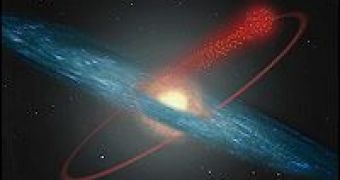There are over 150 star clusters orbiting around the Milky Way and larger galaxies like Andromeda may have up to 500. Astronomers started to observe the Messier 12 cluster in 1999 hoping it's a typical undisturbed cluster. They wanted to observe how clusters evolve under normal conditions.
After surveying more than 16,000 of the cluster's roughly 200,000 stars, researchers found that it lacked the smallest and most common stars. Thus, either Messier 12 was born without any small stars - unlike any other known cluster - or its orbit takes it closer to the dense galactic core than previously thought. Astronomers have found two more anomalous clusters that have been lost their smallest stars as they pass close to the core of our galaxy, so it is most likely that Messier 12 is similar.
A star cluster (or globular cluster) is a spherical group of stars orbiting a galaxy as a satellite. The globular clusters are spherical due to gravity, which packs them very densely (in comparison to a galaxy) especially in their centre.
Globular clusters are a significant part of the history of astronomy because the Sun's position in the Milky Way galaxy has become known by studying them. Until the 1930s, astronomers thought the Sun was located near the middle of the galaxy because the distribution of stars in the observable Milky Way appears uniform. However, the distribution of globular clusters is strongly asymmetric - although there is no particular reason why such an asymmetry should exist. This asymmetry can be explained by assuming that only part of the Milky Way is seen from Earth, and that most of the galaxy is obscured by gas and dust. We know today that this is indeed so, as radio-telescopes have actually seen the other parts of the galaxy - they can do this because radio waves pass unaffected through the gas and dust.
The Messier 12 star cluster seems to have lost around a million stars to our galaxy, where they may reside in its halo. This can be estimated by considering the typical ratio of small stars to large ones in a cluster.
"In the solar neighborhood and in most stellar clusters, the least massive stars are the most common by far," explains Guido de Marchi, an astronomer with the European Space Agency. "Our observations with [the Very Large Telescope in Chile] show this is not the case for Messier 12."
Such gravity-based stripping ultimately leads to the dissolution of the cluster and it appears that Messier 12 may be particularly short-lived compared to its peers. New calculations based on the new estimated trajectory predict that it will disappear in the next 4.5 billion years. The less perturbed clusters last for around 17 billion years.
Although Messier 12 doesn't allow the study of normal cluster evolution as astronomers initially hoped, it does provide an opportunity to study how the Milky Way created a halo of stars stolen from its attendant clusters.
Image credits: ESO

 14 DAY TRIAL //
14 DAY TRIAL //